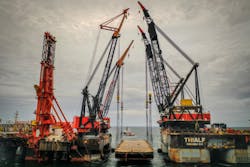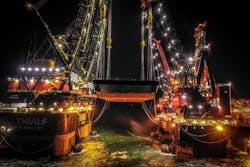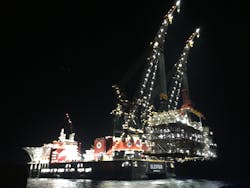Dual-vessel QUAD Lift technique speeds platform installation
Heerema Marine Contractors has developed and proven a pioneering installation technique for giant platforms. QUAD Lift, which is equally applicable to decommissioning, involves parallel deployment of two of the company’s semisubmersible crane vessels to speed up installation/mating at the field location. Thialf and Heerema’s new flagship vessel Sleipnir will jointly provide the capability through their four cranes to quickly install integrated decks weighing up to 30,000 metric tons (29,762 tons), via their respective 14,000 and 20,000-metric ton (15,432 and 22,046-ton) lifting capacity.
According to the company, this capability gives design houses greater freedom early on in a project to optimize platform designs, also providing spin-offs in terms of fabrication flexibility. Decks can be dispatched from a yard to the offshore installation location fully integrated; alternatively, deck modules can be ordered from various fabricators in different countries and then integrated at a yard or a floating barge near the site for subsequent shipment to the field for QUAD Lift installation.
The new procedure was first demonstrated in October 2018 in the US Gulf of Mexico when Thialf and Heerema’s Balder operated in tandem to lift a test structure. The trials fully validated the modelling that had been undertaken at the company’s new Simulation Center in Leiden, the Netherlands.
When Transport and Installation Director Michel Hendriks started working for Heerema over 30 years ago as a young engineer, the company had two semisubmersible crane vessels, Balder and Hermod. “Even then, we were thinking of using the vessels’ four cranes to double their capacity,” he said, “and that thought remained with the company for a long time. But in those days the vessels were new, and we had to get to know their capabilities. And they were operating only with anchors – Balder did not get dynamic positioning (DP) until the late 1990s, and that too took time to fully master. Then we added Thialf, which had DP from the outset.”
According to Coen Spanjers, Engineering Manager T&I Projects, the real impetus for QUAD Lift came in late 2014 when the company sanctioned construction of Sleipnir and started thinking in earnest of combining two heavy-lift vessels for the same project – coinciding with the period when the industry was entering its severest downturn for decades. “Oil and gas is a very cyclical business,” Hendriks explained, “and Heerema is not only driven by how the world might look tomorrow. The vision of the owner is to develop technology for future application.”
“QUAD Lift has also been about harnessing the power of digitalization via the Simulation Center, which opened four years ago. This has two crane domes, each replicating all aspects of the vessels in exact detail, a bridge and control rooms. That technology helped speed up the development and gave us the confidence that we could do QUAD Lift successfully.”
“With this facility,” Spanjers added, “there was no need for conventional tank tests to simulate the vessels’ motions. The full digital twin of the vessels gave us a realistic experience of how they would perform working in parallel under dynamic positioning. When we launched Sleipnir this summer, its first job [installation of the topsides for Noble Energy’s Leviathan platform offshore Israel] was fully successful, proving that what we had seen had been very well mimicked in Leiden. The digital twin provides a hydrodynamic database of all the sea states that we may work in: it allows you to change wave height and wind speeds and to observe how the cranes move. Many of our clients have come to visit the center to see it in action.”
GoM test run
QUAD Lift is said to suit a wide variety of shapes, sizes, and weights of topsides and jackets. The two vessels’ four offshore cranes can boom up to follow the contours of the largest and widest structures, irrespective of the orientation or the foundation type. Working in tandem the cranes lift the topsides cargo from the transport vessel at the field location, position it above the jacket and lower it securely into place. Following set-down, one of the vessels departs while the other typically remains at the site to perform remaining installation activities such as bridges or flares.
For last year’s trial run in the Gulf of Mexico, Heerema used a 400 ft barge which was outfitted to serve as a 4,000 metric ton test weight for the QUAD Lift operation.
“The trial program was designed to confirm all the DP requirements and communication protocols, as modelled in the simulator,” Spanjers explained. “It started with Thialf and Balder opposite each other, stern to stern. Next, the two vessels performed a ‘DP dance’, including a full simultaneous rotation without any loads in the cranes. They then executed the 4,000-t QUAD Lift with the barge, which first was lifted out off the water and thereafter repeating the DP tests.
“Some of our clients that witnessed the trial, asked us why we hadn’t used a heavier test structure, of around 10,000 t, to more accurately simulate a heavier deck lift? In fact, the procedure is harder with a lighter structure: with QUAD Lift, the heavier the load, the slower the response. That makes the cranes and the wires stiffer, and the system therefore more stable.”
“It’s a master-slave arrangement,” Hendriks added, “in which one of the two boats (the master) leads while the other (the slave) follows, and increased stiffness of the system makes the operation easier for the following vessel.
“One of the bigger challenges we were expecting ahead of the trial was the communications: how do you ensure coordinated co-operations between the two vessels’ captains, two superintendents, four crane drivers and two DP operators? So, we called in people from aviation to develop strict communications protocols in order to manage the operation effectively.
“But this is all part of a learning process that goes back to when I first went offshore for Heerema in the late ’80s. As the company’s fleet has expanded, it has always been a case of understanding how a new vessel operates and its response capabilities. From this latest trial, we learned that we had 100% confidence in the QUAD Lift concept, and DNV GL, which witnessed the tests, has certified the process to TRL 6 state of readiness.”
According to Spanjers, “there may be a perception that the process involves having two heavy-lift vessels available for the full duration of a project. In fact, we would typically only need two vessels at the field location for a single day. For virtually any project we would expect to complete the actual installation process within less than a day.”
The sole reason Balder participated in last year’s trials with Thialf was that Sleipnir had at that point not yet been delivered. For topsides of a certain weight, the concept works equally well with any combination of the three vessels, Spanjers said, so Balder could still feature if, for instance, Sleipnir was ruled out due to a prior commitment elsewhere. But for really large development projects Heerema will need to ensure that Sleipnir and Thialf are both in a certain area for the required installation schedule.
In early September, Sleipnir, using its two revolving cranes, set down the two main deck structures on the pre-installed steel jacket at the Leviathan field location offshore Israel. The 15,300-metric ton (16,865-ton) module lift set a new record for a semisubmersible crane vessel, Heerema claimed, the second deck of 9,200 metric ton (10,141 ton) was installed thereafter and the combined operation with a total installed weight of 24,500 metric ton (27,000 ton) was completed in just under 20 hours: “It could have been done in less than 12 hours,” Hendriks said, “if we had not decided to do something else in between the two lifts.”
Re-sized grillage
Heerema can transport fully-integrated decks from most locations directly to the offshore installation site, depending on the client’s fabrication set-up. The company operates its own fleet of cargo barges, the largest of which can carry loads of up to 50,000 metric tons (55,155 tons). For Leviathan, the two main decks were transported from the quayside at the Kiewit yard in Corpus Christi on respectively Heerema barges the H-591 and H-627. “However, we can also accommodate an alternative arrangement,” Spanjers acknowledged, “if, for example, the platform is built in a yard in Asia and the client prefers to use, say, an HTV for the long-haul transportation.”
The company has also optimized the grillage on its cargo barges to be at a height just sufficient to spread the load into the framing. This arrangement is said to minimize the amount of steel in the grillage, with a positive impact on the fatigue life of the topsides. Spanjers explained: “For a heavy floatover installation, you typically need much higher grillage, 10 m (33 ft) up in the air, which is more expensive and leads to significantly increased dynamic loads on the topside.
“With QUAD Lift, there is also more room below our vessels’ cranes and that allows you to design wider, spacier topsides. Spacier also means more design freedom to increase distance between certain functional elements of the topside, which increases the safety of the platform. We have been talking to various design houses which are supportive of this development, because to realize the full benefits QUAD Lift provides to the platform’s design, it is important for it to be considered during the project’s early stages. Early generation platforms also had to have a lot more stiffness built in with elongated support points to connect the load paths. With QUAD Lift, we can position the cranes where we want to optimize the load paths, and that makes both platform assembly and decommissioning process far less costly.”
Hendriks added: “This development is more about the ‘total cost of ownership’ of the project. The physical action of installing a 25,000-t deck is only a relative small part – what is most important is to be able to optimize the design and layout by involving the installation contractor before the EPC award. In this regard we have also been talking to fabricators about really lowering total cost of ownership – because building wider topsides is also cheaper than high topsides.
“Another benefit of our method is that it allows large, fully integrated and commissioned topsides to leave the quayside ready for a QUAD Lift installation, with minimized offshore hook-up and therefore a shorter and more predictable interval until first oil. Twenty-five years ago, topsides design was constrained by the lifting capabilities of the available crane vessels, and typically meant 5,000 to 6,000-t lower deck modules with smaller modules on top (until Thialf arrived, allowing a combination of larger modules – up to 12,000 t – and smaller 6,000-t structures on top).”
The same basic principles of the QUAD Lift method can be re-applied for removing ultra-large and heavy topsides. Sleipnir’s 20,000-t lifting capability should be sufficient for safely removal of most jackets: the vessel’s first job in this mode will be the removal of Shell’s Brent Alpha jacket in the UK northern North Sea.
Johan Sverdrup has shown that the era of large new platforms in the North Sea is not quite over, but the main market for QUAD Lift in this sector is likely to be decommissioning. •
Simulated lifts in 3D
Heerema Marine Contractors describes its Simulation Center in Leiden as a real-time, virtual offshore environment that allows it to integrate clients’ proposed project activities into a 3D view of operations. The crane and vessel controls and the simulated weather and sea swell patterns are said to provide authentic visualization and a ‘feel’ for all aspects of how the planned operation might pan out.
The Simulation Center can be used to assess and test offshore installation programs prior to going offshore, allowing designs to be ‘frozen’ earlier. This helps speed up engineering and onshore fabrication, ensuring a greater likelihood of timely delivery of all installation components and required hardware. In addition, the facility can be used to test new approaches for existing or future projects, or to scrutinize critical planned operations in order to check for potential trouble spots.
Heerema can adapt a wide range of 3D models of, for example, jackets and topsides to run realistic scenarios, including single, repetitive or dual-crane lifts, and float over operations. The engineering department develops 3D drawings for each project, incorporating the selected equipment characteristics in order to recreate the components’ natural behavior, uploading the results into the Simulation Center system. The offshore crew will then come in to perform a dry run of the planned operation for the benefit of the client and project team, helping all parties anticipate any technical issues or potential failure modes that might occur.
About the Author
Jeremy Beckman
Editor, Europe
Jeremy Beckman has been Editor Europe, Offshore since 1992. Prior to joining Offshore he was a freelance journalist for eight years, working for a variety of electronics, computing and scientific journals in the UK. He regularly writes news columns on trends and events both in the NW Europe offshore region and globally. He also writes features on developments and technology in exploration and production.



